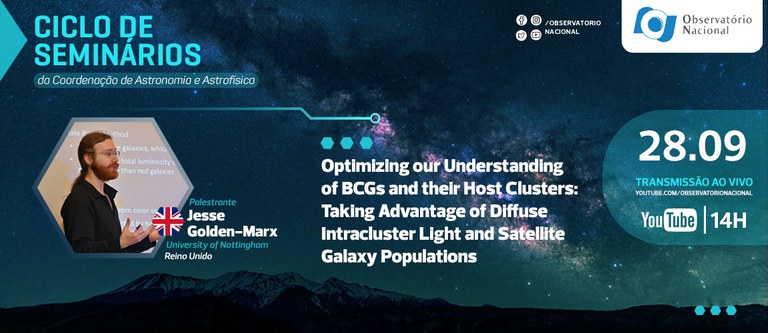Notícias
Seminário da Astronomia do ON fala sobre Aglomerados de Galáxias e suas galáxias mais brilhantes

Na quinta-feira, dia 28 de setembro, a Coordenação de Astronomia e Astrofísica (COAST) do Observatório Nacional (ON/MCTI) realizará uma nova edição de seu seminário.
O evento virtual acontecerá às 14h (horário de Brasília) e terá transmissão ao vivo por meio do Canal do ON no YouTube. O tema será “Optimizing our Understanding of BCGs and their Host Clusters: Taking Advantage of Diffuse Intracluster Light and Satellite Galaxy Populations”.
Para falar sobre o assunto, foi convidado o Dr. Jesse Golden-Marx, pesquisador associado sênior da Universidade de Nottingham, no Reino Unido.
Título: Optimizing our Understanding of BCGs and their Host Clusters: Taking Advantage of Diffuse Intracluster Light and Satellite Galaxy Populations
Resumo: At the heart of every galaxy cluster is the brightest central galaxy (BCG). The central location of the BCG along with its unique formation history yield the underlying galaxy-dark matter halo connection. This statistical correlation enhances our understanding of the assembly and evolution of BCGs over cosmic time. However, we gain further insight into the formation and evolution of BCGs as well as that of the clusters they live in by taking advantage of all available data within the cluster environment namely the (1) intracluster light and (2) satellite galaxy population. Here, I present results from two recent papers. The first focuses on using clusters from the DES-ACT overlap region to study the evolution of the ICL’s stellar properties (mass and color) over the redshift range 0.20 < z < 0.80. In this analysis, we also show how incorporating the ICL enhances the galaxy – halo connection. The second project focuses on using the conditional luminosity function (CLF) to characterize the satellite populations within clusters. However, because cluster science and cosmology rely on the choice of cluster finder, we investigate whether biases exist between clusters identified using either the redMaPPer or Yang cluster finders. We directly compare the CLFs and the weak gravitational lensing measurements as a function of richness and for clusters cross-identified within both catalogues. Although the satellite galaxy properties slightly differ, we find that there’s no difference in the underlying halo mass for the most massive clusters.
Link para live no YouTube: https://www.youtube.com/watch?v=rYgteraxqeM
Durante este ano, os seminários da COAST estão acontecendo de forma presencial, híbrida ou remota – pelo canal do ON no YouTube.
Para mais informações: seminarioscoast@on.br
As edições anteriores estão disponíveis na playlist.